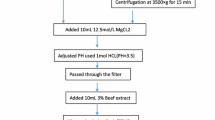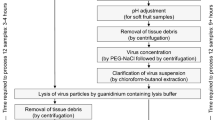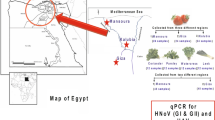Abstract
Hepatitis A is a major infectious disease epidemiologically associated with foodborne and waterborne outbreaks. Molecular detection using real-time RT-PCR to detect the hepatitis A virus (HAV) in contaminated vegetables can be hindered by low-virus recoveries during the concentration process and by natural PCR inhibitors in vegetables. This study evaluated three virus concentration methods from vegetables: polyethylene glycol (PEG) precipitation, ultrafiltration (UF), and immunomagnetic separation (IMS). UF was the most efficient concentration method, while PEG and IMS were very low for the recovery rate of HAV. These results demonstrate that UF is the most appropriate method for recovering HAV from contaminated vegetables and that this method combined with the real-time RT-PCR assay may be suitable for routine laboratory use.
Similar content being viewed by others
References
Bidawid, S., Farber, J. M., & Sattar, S. A. (2000). Rapid concentration and detection of hepatitis A virus from lettuce and strawberries. Journal of Virological Methods, 88, 175–185.
Boxman, I. L., Tilburg, J. J., te Loeke, N. A., Vennema, H., de Boer, E., & Koopmans, M. (2007). An efficient and rapid method for recovery of norovirus from food associated with outbreaks of gastroenteritis. Journal of Food Protection, 70, 504–508.
Butot, S., Putallaz, T., & Sanchez, G. (2007). Procedure for rapid concentration and detection of enteric virus from berries and vegetables. Applied and Environmental Microbiology, 73, 186–192.
Choi, W. (2005). Establishment of detection method for norovirus, Technical report (pp. 16–17). Seoul: Korea Food & Drug Administration.
Dubois, E., Hennechart, C., Merle, G., Burger, C., Hmila, N., Ruelle, S., et al. (2007). Detection and quantification by real-time RT-PCR of hepatitis A virus from inoculated tap waters, salad vegetables, and soft fruits: characterization of the method performances. International Journal of Food Microbiology, 117, 141–149.
Fino, V. R., & Kniel, K. E. (2008). Comparative recovery of foodborne viruses from fresh produce. Foodborne Pathogens and Disease, 5, 819–825.
Fiore, A. E., Wasley, A., & Bell, B. P. (2006). Prevention of hepatitis A through active or passive immunization: recommendations of the Advisory Committee on Immunization Practices (ACIP). Morbidity and Mortality Weekly Report, 55, 1–23.
Flore, A. E. (2004). Hepatitis A transmitted by food. Clinical Infectious Disease, 38, 705–715.
Gilpatrick, S. G., Schwab, K. J., Estes, M. K., & Atmar, R. L. (2000). Development of an immunomagnetic capture reverse transcription-PCR assay for the detection of Norwalk virus. Journal of Virological Methods, 90, 69–78.
Guillois-Becel, Y., Couturier, E., Le Saux, J. C., Roque-Afonso, A. M., Le Guyader, F. S., Le Goas, A., et al. (2009). An oyster-associated hepatitis A outbreak in France in 2007. Euro Surveillance, 14, 1–6.
Ha, S., Woo, G., Hwang, I., & Choi, W. (2009). Development of a virus elution and concentration procedure for detecting norovirus in oysters. Food Science and Biotechnology, 18, 1150–1154.
Hooper, R. R., Juels, C. W., Routenberg, J. A., Harrison, W. O., Kilpatrick, M. E., Kendra, S. J., et al. (1977). An outbreak of type A hepatitis at the Naval Training Center, San Diego: epidemiologic evaluation. American Journal of Epidemiology, 105, 148–155.
Jothikumar, N., Cliver, D. O., & Mariam, T. W. (1998). Immunomagnetic capture PCR for concentration and detection of hepatitis A virus from environmental samples. Applied and Environmental Microbiology, 64, 504–508.
Jothikumar, N., Cromeans, T. L., Sobsey, M. D., & Robertson, B. H. (2005). Development and evaluation of a broadly reactive TaqMan assay for rapid detection of hepatitis A virus. Applied and Environmental Microbiology, 71, 3359–3363.
Kittigul, L., Pombubpa, K., Rattanatham, T., Diraphat, P., Utrarachkij, F., Pungchitton, S., et al. (2008). Development of a method for concentrating and detecting rotavirus in oysters. International Journal of Food Microbiology, 122, 204–210.
Koopmans, M., & Duizer, E. (2004). Foodborne viruses: An emerging problem. International Journal of Food Microbiology, 90, 23–41.
Koopmans, M., von Bonsdorff, C. H., Vinje, J., de Medici, D., & Monroe, S. (2002). Foodborne viruses. FEMS Microbiology Reviews, 26, 187–205.
Love, D. C., Casteel, M. J., Meschke, J. S., & Sobsey, M. D. (2008). Methods for recovery of hepatitis A virus (HAV) and other viruses from processed foods and detection of HAV by nested RT-PCR and TaqMan RT-PCR. International Journal of Food Microbiology, 126, 221–226.
McCaustland, K. A., Bond, W. W., Bradley, D. W., Ebert, J. W., & Maynard, J. E. (1982). Survival of hepatitis A virus in feces after drying and storage for one month. Journal of Clinical Microbiology, 16, 957–958.
Moon, A., Hwang, I., & Choi, W. (2009). Development of a virus elution and concentration procedure for detecting norovirus in cabbage and lettuce. Food Science and Biotechnology, 18, 407–412.
Myrmel, M., Rimstad, E., & Wasteson, Y. (2000). Immunomagnetic separation of a Norwalk-like virus (genogroup I) in artificially contaminated environmental water samples. International Journal of Food Microbiology, 62, 17–26.
Papafragkou, E., Plante, M., Mattison, K., Bidawid, S., Krthikeyan, K., Farber, J. M., et al. (2008). Rapid and sensitive detection of hepatitis A virus in representative food matrices. Journal of Virological Methods, 147, 177–187.
Petriqnani, M., Verhoef, L., van Hunen, R., Swaan, C., van Steenbergen, J., Boxman, I., et al. (2010). A possible foodborne outbreak of hepatitis A in the Netherlands, January–February 2010. Euro Surveillance, 15, pii19512.
Pinto, R. M., Costafreda, M. I., & Bosch, A. (2009). Risk assessment in shelfish-borne outbreaks of hepatitis A. Applied and Environmental Microbiology, 75, 7350–7355.
Robesyn, E., De Schrijver, K., Wollants, E., Top, G., Verbeeck, J., & Van Ranst, M. (2009). An outbreak of hepatitis A associated with the consumption of raw beef. Journal of Clinical Virology, 44, 207–210.
Rowe, S. L., Tanner, K., & Gregory, J. E. (2009). Hepatitis A outbreak epidemiologically linked to a food handler in Melbourne, Victoria. Communicable Diseases Intelligence, 33, 46–48.
Rzezutka, A., D’Agostino, M., & Cook, N. (2006). An ultracentrifugation-based approach to the detection of hepatitis A virus in soft fruits. International Journal of Food Microbiology, 108, 315–320.
Acknowledgments
This study was supported by the Basic Science Research Program through the National Research Foundation of Korea (NRF) funded by the Ministry of Education, Science and Technology (2009-0085532).
Author information
Authors and Affiliations
Corresponding authors
Rights and permissions
About this article
Cite this article
Lee, K.B., Lee, H., Ha, SD. et al. Comparative Analysis of Viral Concentration Methods for Detecting the HAV Genome Using Real-Time RT-PCR Amplification. Food Environ Virol 4, 68–72 (2012). https://doi.org/10.1007/s12560-012-9077-x
Received:
Accepted:
Published:
Issue Date:
DOI: https://doi.org/10.1007/s12560-012-9077-x




